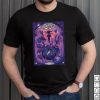Tennessee Volunteers Morgan Wallen I’m Wearing Tennessee Orange Signature shirt
Hmmm . . . not to doubt your word or anything, but are you sure your diagnosis (and your aunt’s) was pancreatic cancer and not pancreatitis? The latter is an Tennessee Volunteers Morgan Wallen I’m Wearing Tennessee Orange Signature shirt (and very painful) condition that can be completely cured or it can become chronic, controlled by diet and medications but subject to occasional flare-ups. Chronic pancreatitis can lead to pancreatic cancer, but pancreatic cancer can occur without any prior pancreatitis. Diabetes is a risk factor for both pancreatitis and pancreatic cancer. Pancreatic cancer (not to be confused with pancreatic endocrine tumors) is extremely rare in persons under 40, and it has very low survival rates — on average less than 5% of persons with pancreatic cancer will survive 5 years. That rate is somewhat better — about 16% — if the cancer is discovered when it is still localized to the pancreas, but this occurs in less than 20% of cases. Symptoms of early-stage pancreatic cancer are vague and often mistaken for other less serious conditions or even just tolerated and ignored. Given your family history with pancreatic conditions, your mother would be well advised to be extra vigilant about any possible symptoms: pain in the upper abdomen or back, loss of appetite, unexplained weight loss, fatigue, nausea and vomiting, yellow eyes or skin or dark urine (jaundice). However, almost none of these symptoms become noticeable until the disease is past the earliest, most survivable stage.
 ()
()Tennessee Volunteers Morgan Wallen I’m Wearing Tennessee Orange Signature shirt
The first thing to know is that the Tennessee Volunteers Morgan Wallen I’m Wearing Tennessee Orange Signature shirt of Matthew’s Gospel used the Greek word magi, which does not actually mean ‘wise men’, but is a reference to the priests of the then-great Zoroastrian religion of the Persian Empire. When Matthew says they came from the east, he was alluding to the direction of Babylon and Persia. It is, of course, inconceivable that Zoroastrian priests would be in the least interested in the birth of a purported king of Judah. It is scientifically inconceivable that a star could be followed so accurately to Jerusalem and then to Bethlehem and actually stand over the very house where Jesus was. However, our author (he was anonymous and very unlikely to have been called Matthew) knew that the magi were well known for their wisdom and for their knowledge of astrology, so he knew this nativity account would be plausible.
 ()
() ()
()CUSTOMER REVIEWS & FEEDBACK
- Production Time: All orders are processed within 3 – 4 business days.
- Shipping Time: You will receive your order anywhere from 5 – 10 business days (depending on the shipping method you chose) from the date that it is shipped out, not the date the order is placed.
- Return & Exchange: A full-refund of your purchase! Absolutely risk-free, no question asked. In case of defective or damaged goods, we will send a replacement to you (No any extra fee) within 30 days since your purchase.
- Tracking Number: When available, we will send you the tracking number with the confirmation email so that you can track the package online.
- Worldwide Shipping Available: At limotees, we ships products to over 100 countries worldwide. Shipping rates and fees may vary depending on your country or region.
- If you have any other queries, please feel free to email us at [email protected]
- All Shirts are pressed on a professional heat press.
- Runs true to size
- Please see the size chart to get the right size for you.
- Please be aware that the colors may appear a little different on your computer monitor when compared to the actual shirt (All Computer Screens Project Different Hues).
- A Nightmare On Elm Street Art T-Shirt Freddy Krueger Shirt Men’s Women’s. Some are photographed and captioned to be displayed more towards men or women but will look good on any person.
Classic T-Shirt
- 100% Cotton (fiber content may vary for different colors)
- Medium fabric (6.0 oz/yd² (203 g/m²))
- Classic fit
- Tear away label
- Runs bigger than usual
Hoodie
- 50% Cotton 50% Polyester
- Medium-heavy fabric (8.0 oz/yd² (271.25 g/m²))
- Classic fit
- Tear away label
- Runs true to size
Sweatshirt
- 50% Cotton 50% Polyester
- Medium-heavy fabric (8.0 oz/yd² (271.25 g/m²))
- Loose fit
- Sewn in label
- Runs true to size
Long Sleeve
- 100% Cotton (fiber content may vary for different colors)
- Medium fabric (6.0 oz/yd² (203 g/m²))
- Classic fit
- Sewn in label
- Runs smaller than usual
Women T - Shirt
- 100% Cotton (fiber content may vary for different colors)
- Medium fabric (6.0 oz/yd² (203 g/m²))
- Classic fit
- Tear away label
- Runs bigger than usual
V-Neck T-Shirt
- 100% Ringspun cotton (fiber content may vary for different colors)
- Light fabric (4.5 oz/yd² (153 g/m²))
- Semi fitted
- Tear away label
- Runs true to size
Tank Top
- 100% Ringspun cotton (fiber content may vary for different colors)
- Light Fabric (4.5 oz/yd² (153 g/m²))
- Sleeker fit
- Tear away label
- Runs true to size
This Flowers having a Weird Mom builds character Xmas Day T-shirt, hoodie, sweater, tank top, long sleeve, and V-neck t-shirt is a made-to-order product, It is designed by Limotees LLC. This is a limited edition product was made in the USA.
Brand: Limotees Clothing LLC, Inc. - An online fashion company in the USA
At Limotees LLC, we have provided quality T-shirts that are sure to make you feel comfortable and cool even in the scorching heat or cold weather. We also seek to provide our customers with the highest level of customer service possible by adhering to customer satisfaction policies and an open communication style. T-SHIRT FEATURES: - High quality 100% Soft cotton (fiber content may vary for different colors) UNISEX shirt. HOODIE and SWEATSHIRTS FEATURES: - 50% Cotton; 50% Polyester (fibre content may vary for different colors) - IMPORTANT: Runs true to size. Are buyers responsibility to consult the size chart before placing the order. - The design is printed on the t-shirt with a digital printer. - If you want to CUSTOMIZE more this product, please send me a message. CARE: - Machine wash, with cold water, and inside out - Tumble dry on low or hang to dry - DO not iron directly on the design ♥ HOW TO ORDER T-SHIRT, HOODIE, SWEATSHIRT , LONGSLEEVE











